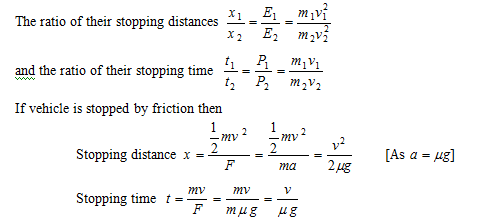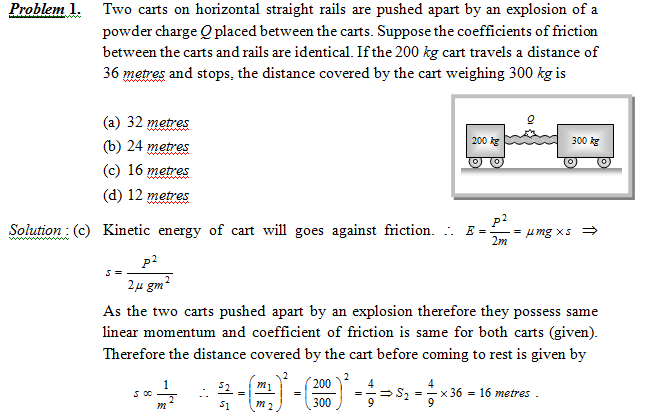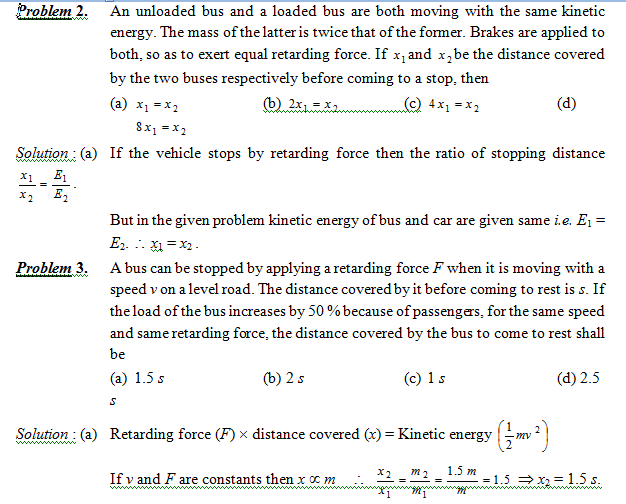
Stopping Distance Formula of physics formula for comparing the stopping distance and time for two vehicles can be derived from the equations of motion and the principles of kinematics. To compare the stopping distance and time for two vehicles, you need to consider factors like initial velocity, deceleration (negative acceleration), and the distance over which each vehicle comes to a stop.
Assuming that both vehicles start from the same initial velocity and experience the same deceleration, you can use the following formulas to compare their stopping distances and times:- Stopping Distance (d):
Also Check - Work Done in Raising a Box Formula
- Stopping Time (t):
 To compare the stopping distance and time for two vehicles, you can use these formulas for each vehicle separately. If you have the values of initial velocity and deceleration for both vehicles, you can calculate their respective stopping distances and times and then compare them to see which vehicle will stop in a shorter distance and in less time.
To compare the stopping distance and time for two vehicles, you can use these formulas for each vehicle separately. If you have the values of initial velocity and deceleration for both vehicles, you can calculate their respective stopping distances and times and then compare them to see which vehicle will stop in a shorter distance and in less time.
Also Check - Work Done by a Variable Force Formula
Importance Of Stopping Distance And Time
Comparing the stopping distance and time for two vehicles is important for several reasons:- Safety : Understanding and comparing the stopping capabilities of different vehicles is crucial for road safety. It helps drivers and road users make informed decisions about following distances, safe driving speeds, and reaction times, reducing the likelihood of accidents.
- Accident Prevention: Knowledge of stopping distances and times allows drivers to anticipate potential hazards and respond effectively. Being aware of a vehicle's stopping capabilities can help prevent rear-end collisions and other accidents.
- Vehicle Choice : When purchasing or selecting a vehicle, individuals and organizations consider factors like braking performance. Comparing stopping distances and times helps consumers choose vehicles with better safety features and capabilities.
- Traffic Engineering: City planners and traffic engineers use data on stopping distances and times to design roads, intersections, and traffic signals that ensure safe and efficient traffic flow.
- Legal and Regulatory Compliance: Many countries have regulations and standards regarding vehicle braking performance. Vehicle manufacturers must meet these standards, and consumers rely on them when purchasing vehicles.
- Education and Training: Stopping distance and time are essential concepts taught in driver's education programs. Educating drivers about these concepts helps them become safer and more responsible road users.
- Emergency Situations: In emergency situations, such as avoiding collisions or reacting to unexpected obstacles, knowing the stopping capabilities of a vehicle can be a life-saving factor. Drivers can make split-second decisions based on their knowledge of their vehicle's performance.
- Performance Evaluation: Comparing the stopping distances and times of different vehicles can provide valuable feedback for vehicle manufacturers and automotive engineers. It helps identify areas for improvement in braking systems and overall vehicle safety.
- Improved Driving Habits : Understanding stopping distances and times encourages responsible driving habits, such as maintaining safe following distances, obeying speed limits, and avoiding aggressive driving behavior.
Also Check- Work, Energy & Power Formula
In summary, comparing the stopping distance and time for vehicles is important because it directly affects road safety, informs vehicle purchasing decisions, contributes to traffic management and infrastructure design, and promotes responsible driving habits. This knowledge helps prevent accidents, save lives, and improve the overall safety of road transportation systems.Examples


Stopping Distance And Time Formula FAQs
What is stopping distance?
Stopping distance is the distance a vehicle travels from the moment the brakes are applied until the vehicle comes to a complete stop.
Why is knowing stopping distance important for drivers?
Understanding stopping distance is crucial for drivers to maintain safe following distances and react effectively to road conditions and obstacles.
What factors affect stopping distance?
Stopping distance is influenced by initial speed, road conditions (e.g., wet or dry), tire quality, braking efficiency, and vehicle weight.
How is stopping time related to stopping distance?
🔥 Trending Blogs
Talk to a counsellorHave doubts? Our support team will be happy to assist you!

Free Learning Resources
PW Books
Notes (Class 10-12)
PW Study Materials
Notes (Class 6-9)
Ncert Solutions
Govt Exams
Class 6th to 12th Online Courses
Govt Job Exams Courses
UPSC Coaching
Defence Exam Coaching
Gate Exam Coaching
Other Exams
Know about Physics Wallah
Physics Wallah is an Indian edtech platform that provides accessible & comprehensive learning experiences to students from Class 6th to postgraduate level. We also provide extensive NCERT solutions, sample paper, NEET, JEE Mains, BITSAT previous year papers & more such resources to students. Physics Wallah also caters to over 3.5 million registered students and over 78 lakh+ Youtube subscribers with 4.8 rating on its app.
We Stand Out because
We provide students with intensive courses with India’s qualified & experienced faculties & mentors. PW strives to make the learning experience comprehensive and accessible for students of all sections of society. We believe in empowering every single student who couldn't dream of a good career in engineering and medical field earlier.
Our Key Focus Areas
Physics Wallah's main focus is to make the learning experience as economical as possible for all students. With our affordable courses like Lakshya, Udaan and Arjuna and many others, we have been able to provide a platform for lakhs of aspirants. From providing Chemistry, Maths, Physics formula to giving e-books of eminent authors like RD Sharma, RS Aggarwal and Lakhmir Singh, PW focuses on every single student's need for preparation.
What Makes Us Different
Physics Wallah strives to develop a comprehensive pedagogical structure for students, where they get a state-of-the-art learning experience with study material and resources. Apart from catering students preparing for JEE Mains and NEET, PW also provides study material for each state board like Uttar Pradesh, Bihar, and others
Copyright © 2025 Physicswallah Limited All rights reserved.
Get App









